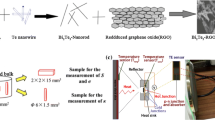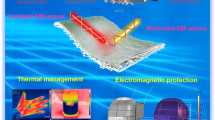Abstract
The resultant Seebeck coefficient α of the touching p- and n-type M/Bi–Te/M (M = Cu and Ni) composites was measured as a function of z at a scan step of 0.5 mm using thermocouples set at three different intervals of s = 4, 6.5 and 8 mm, where s is the interval between two probes and z is the distance from the center of Bi–Te compound to the middle of two thermocouples. Bi–Te compounds have a thickness of t Bi–Te = 6 mm but the thickness t M of both end metals sandwiching their compounds was varied from 0.5 mm to 6 mm. The composites were compacted tightly at a force of about 10 N by a ratchet. When two probes are placed on both end metals, the resultant α was significantly enhanced and exhibited a tendency to increase as s approaches t Bi–Te, like the welded composites. The enhancement in α is attributed to the contribution from the barrier thermo-emf generated near the interface. When the thickness t 0 of metal outside two probes set at s = 6.5 mm was increased from 0.25 mm to 5.75 mm, the averaged α for M = Cu and Ni was increased by 3.8% in the p-type composite, while reversely it was decreased by 4.8% in the n-type one. It was first observed that t 0 also has a significant influence on the resultant α. The maximum α of the p- and n-type Ni/Bi–Te/Ni composites then reached great values of 264 μV/K at t M = 6 mm (corresponding to t 0 = 5.75 mm) and −280 μV/K at t M = 1.2 mm (corresponding to t 0 = 0.95 mm), respectively, which are 29% and 23% larger in absolute value than their intrinsic α values. These maximum α were barely changed with time. It was thus found that the barrier thermo-emf is generated steadily even in touching composites and the resultant α is highly sensitive to the position of leads connected to the metal electrode of a thermoelement.








Similar content being viewed by others
References
Wood C (1988) Prog Phys 51:459
Mahan G, Sales B, J Sharp (1997) Phys Today 50:42
Hicks LD, Dresselhaus MS (1993) Phys Rev B 47:12727
Hicks LD, Harman TC, Dresselhaus MS (1993) Appl Phys Lett 63:3230
Broido DA, Reinecke TL (1995) Appl Phys Lett 67:1170
Goldsmid HJ (1964) Thermoelectric refrigeration. Plenum, NewYork
Koga T, Rabin O, Dresselhaus MS (2000) Phys Rev B 62:16703
Venkatasubramanian R, Siivola E, Colpitts T, O’quinn B (2001) Nature 413:597
Bergman DJ, Levy O (1991) J Appl Phys 70:6821
Tauc J (1953) Czechosl J Phys 3:282
Balmush II, Dashevsky ZM, Kasiyan AI (1995) Semiconductors 29:937
Yamashita O, Odahara H (2006) J Mater Sci 41:2795
Odahara H, Yamashita O, Satou K, Tomiyoshi S, Tani J, Kido H (2005) J Appl Phys 97:103722
Yamashita O, Odahara H, Satou K, Tomiyoshi S (2006) J Mater Sci 41:3089
Dashevsky ZM, Kasiyan AI, Kolomoets NV (1989) In: Proceedings of the 8th international conference on thermoelectric energy conversion, Nancy, France, 1989, p 200
Yamashita O, Tomiyoshi S (2004) J Appl Phys 95:6277
Yamashita O, Tomiyoshi S (2004) J Appl Phys 95:161
Yim WM, Rosi FD (1972) Solid State Electron 15:1121
Yamashita O, Tomiyoshi S (2003) Jpn J Appl Phys 42:492
Yamashita O, Odahara H, Tomiyoshi S (2004) J Mater Sci 39:5653
Kittel C (1996) Introduction to solid state physics. John Wiley & Sons, NewYork
Author information
Authors and Affiliations
Corresponding author
Rights and permissions
About this article
Cite this article
Yamashita, O., Odahara, H. Enhancement of the Seebeck coefficient in touching M/Bi–Te/M (M = Cu and Ni) composites. J Mater Sci 41, 7437–7445 (2006). https://doi.org/10.1007/s10853-006-0810-4
Received:
Accepted:
Published:
Issue Date:
DOI: https://doi.org/10.1007/s10853-006-0810-4




